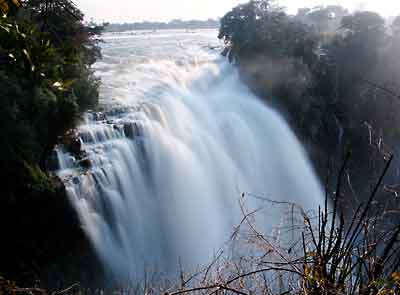 |
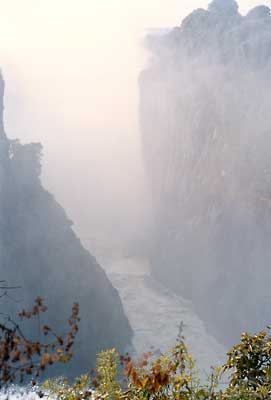 |
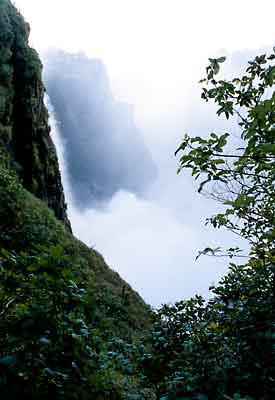 |
In the competitive world of twiddle-the-qualifications-until-you-achieve-a-record, Victoria Falls holds the honor as "largest sheet of falling water in the world." Although not spectacularly high, only about 100 meters, the Falls are quite long, about 1.7 km. Prior to being "discovered" by David Livingstone in 1855, the Falls had been called "Mosi oa Tunya," or "the smoke that thunders" by the recently-arrived Makalolo people, or "Amanza Thunquayo," "water rising as smoke" by the earlier Ndebele tribes. A statue of Livingston stands next to the Falls, and it was decided at the time of Zimbabwe's independence not to change the name, to maintain a brand familiarity and keep the tourists coming in.
Vic Falls is not your standard water-goes-off-the-side-of-a-cliff type of waterfall, but rather it plunges down a narrow chasm in the ground, and the main viewing area across the river is at the same level as the top of the Falls. The Falls we see today are actually about the eighth incarnation of falling water along that stretch of the Zambezi River. In the last two million years, a series of falls have existed for a time and carved out a series of dramatic gorges downstream (none of which we had time to see..) until the water reached a soft spot in surrounding hard rock and formed the chasm falls seen today. The original Falls was 8 km downstream of the present location.
 |
 |
 |
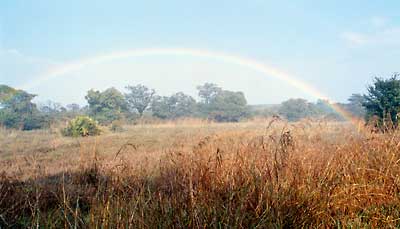 The constant mist from the waterfall creates a rainbow 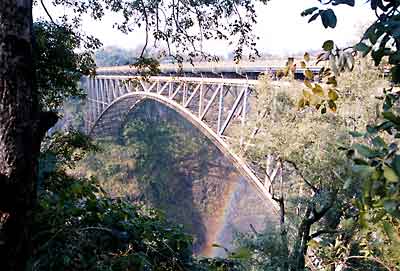 |
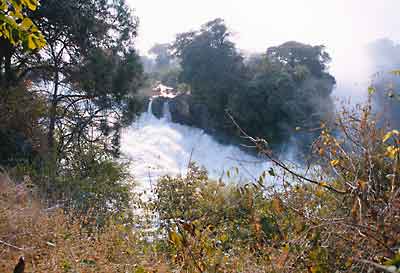 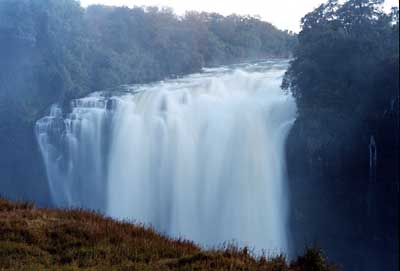 |
The area right across from the Falls gets an almost constant misting of water, and is thus more of a rainforest environment. A footpath traverses the entire length of the Falls, offering several dramatic-and frequently wet-views of the smoking water. I'd read about the necessity of having rain gear when you tour the falls, so I'd brought along some lightweight backpacker's rain gear. But the UTc people had large, heavy raincoats available for us, so I put on one of those for good measure. We started at the west end of the rainforest trail, by the statue of Livingston. At first, I got the impression that the rain gear was not really necessary. There was just a light mist that blew up every once in awhile, and a heavy raincoat was just an encumbrance. But as we headed down the trail, that changed, and there were stretches of the last fourth or so of the trail that were like being in a heavy rainstorm. Despite the raincoats, many of us still emerged at the end soaked through to the skin, and had to spend awhile at the visitor's center back at the start drying out. I think if I went again, I'd bring a towel to leave behind in the bus. And my Nikonos underwater camera. It was pretty much impossible to photograph in many of the overlooks, just too much water coming down.
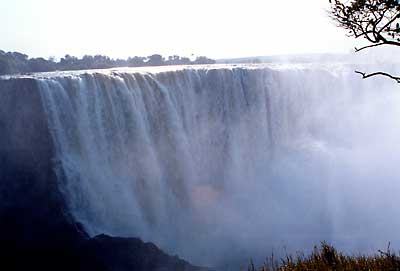 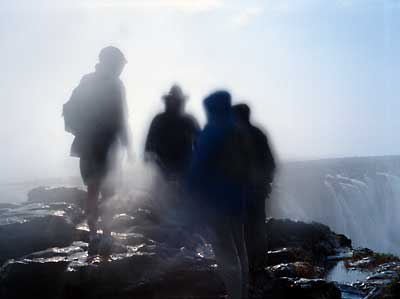 Ghosts in the mist Photo by Pam Bloxham |
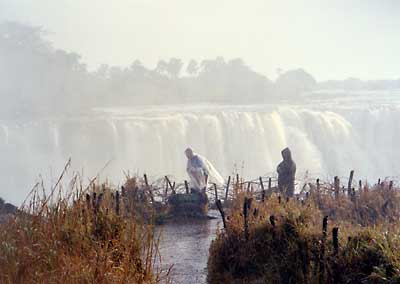 Photo by Kathy Lindquist 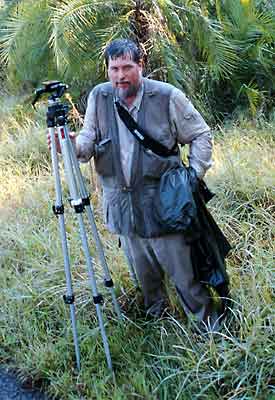 Drowned Rat Dave: despite the raincoat, one still gets a little damp walking near the falls. Photo by Ron Ebert |
| By arranging to have our luggage loaded earlier in the day, a few of us did manage to wrangle an hour in the unabashedly-tourist-trap shopping area of the town. We concentrated on "curio row," a street that has a series of established shops at the near end, and then a shark-infested free-for-all of craft sellers at the other end. There is a line where the last permanent shop is, and the freelancers are not allowed to cross it to grab customers; several policemen patrol the area carrying small billy clubs, and it's clear that the freelancers know from experience that you don't cross the line. The cops will also act quickly to shoo away beggars when they see them bothering tourists. | 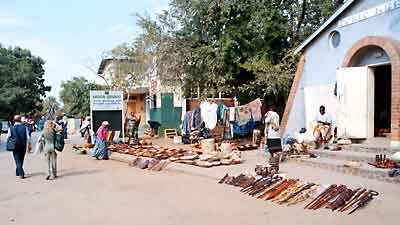 Curio row |
When we were getting back on the bus after our tour of the Falls, a horde of craft sellers appeared out of nowhere and pressed against the windows of the bus, trying to make a quick sale. When a cop suddenly appeared on the scene, they scattered faster than a herd of impala at a lion convention.
Vic Falls seems to be pretty serious about keeping the tourist dollars flowing as vigorously as the Falls, the guides told us that crimes against tourists are almost non-existent in the town. That is, if you don't count the cut-throat haggling that goes on at the far end of curio row as a crime. That end of the street isn't for the faint of heart; the sellers are all extremely aggressive, and any eye contact or a glance at their wares is considered a sign of interest. It's normal for them to begin by quoting a price that's four times or more higher than what they want, and then you're expected to haggle them down. The sellers also look you over from head to foot and may offer to trade for any number of things you have on you: a nice pen, sunglasses, athletic shoes, even literally the shirt off your back.
American dollars are not only welcome everywhere, they're usually preferred. The exchange rate for Zimbabwe dollars varies wildly, and you can get up to double the rate of a legit foreign exchange bureau by finding the right street money changer...or, you can wind up with a roll of newspaper or worthless money from other African countries.
There are a few standard craft items that just about everyone there sells: carved wooden hippos, giraffes and lions, tablecloths woven with traditional designs, crudely-made drums, and Zambezi walking sticks. These are rather interesting carved sticks that depict a standard set of images from the culture of the Tonga people who used to live along the Zambezi until the rising waters of Lake Kariba dispersed them in the 1950's. The sticks are properly carved from a single log, and vary considerably in their quality, length, price, and details.
In the shark end of town, I spotted a nice walking stick, but I'm worthless at bargaining, so I got Pam to do the dirty work for me. They initially asked $15, Pam got them down to $9. The difference to me was trivial, and I always feel just a little guilty talking local people down like this (which is, of course, part of their well-rehearsed strategy) over an amount that's trivial to me but significant to them. However, I have read that those who pay the full price without bargaining are actually held in contempt by the locals, and that can even set off disastrous price-hike wars among the sellers, hurting all the businesses in the long run.
So now I had this delicate meter-long carved stick to schlep around, and to try and not get it broken or kill anybody with the pointy end.
After about an hour in the shopping area, the bus returned to collect us, and we set off for Botswana. Zimbabwe and Botswana are a study in contrasts and the shifting fortunes of African politics. Back in the Rhodesia days, Zimbabwe was one of the most prosperous African nations, while Botswana was among the poorest. Of course, some of that prosperity was built on the backs of the original native population, which is why the country still has so much unrest today. Today, the roles have reversed. Zimbabwe seems to be in a downward spiral, with economic woes, and social and political unrest, while Botswana is in fine shape, due mainly to large diamond deposits that have been discovered over the past few decades. The government is stable, and they have enlightened policies balancing tourism with minimal environmental impact. As we crossed the border, a large sign welcomed us to Botswana, and sternly advised that corruption was not tolerated, and we should neither offer nor pay bribes. We got the impression we would like it here, and we were not disappointed, for the most part.
| Just over the border, we were required to stop and perform hoof-and-mouth disease decontamination. By the side of the road, there was a shallow pan with a rag in the bottom of it and a canister of disinfectant which was pumped onto the rag. You have to step in the pan and wipe your feet on the rag. Then, of course, you walk back through the dirt, losing the disinfectant off your shoes, and get back into your vehicle and put your feet back down in the same germ-laden places they were in before, so I'm not sure how effective the procedure really is. Also, there was nobody manning the station, it seemed to be purely on the honor system. | 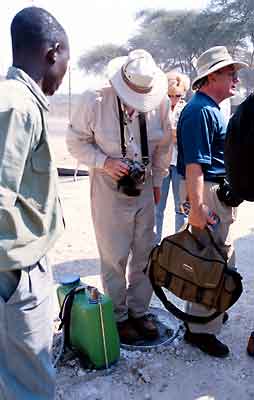 Wipe yer hoofs before you come into our country |
We were headed towards the Kasane airport, where we would catch the first of our bush planes out to Camp Moremi, situated on the Xakanaxa Lagoon, deep in the eastern part of the Okavango Delta wilderness. Along the way, we spotted a recently-crashed bush plane right by the side of the road, which filled us with a lot of confidence. At Kasane, the bus with our excess heavy luggage went on ahead to the nearby Mowana Safari Lodge, which was to be our last stop, and we were left with only our (supposedly) 10 kg of bush luggage. But as everything was gathered in the airport, it was obvious to me that not everybody in the tour group had bothered to pare their luggage down to the limit...in fact, few had. Some of the bags looked like they might have been a good 15 or even 20 kg, and there was also more than one hard-sided suitcase, which was another thing we had been told from the start was a no-no. The five of us kinda felt like chumps at that point, having spent so much time, effort, and money to get down to the weight limit. Being a devout pessimist (we in the church actually prefer the term "realist"), I had been predicting from the start that we would find this to be the case, that the weight limit wasn't really that restrictive...but there was a limit. Later in the trip, we heard of another tour group that was forced to repack and store their excess luggage.
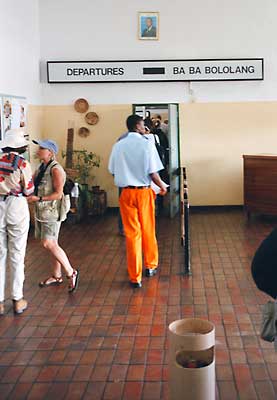 Don't say "so long," say "ba ba bololang." The Kasane airport. |
The Kasane airport was big enough to have an x-ray machine for carry-on bags, but they apparently had not been able to afford the proper training for machine operators. The lone guy at the x-ray machine spent his time feeding bags through, and never even once glanced at the display. |
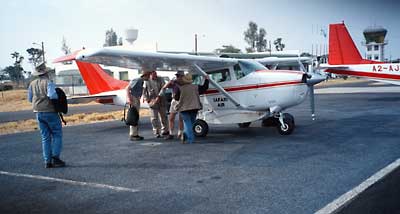 Photo by Kathy Lindquist |
After more waiting in a featureless airport, a small fleet of tiny bush planes descended from the sky, and we were finally led out to the runway. These planes were so small that there is actually a different procedure for getting into them depending on where you're sitting. The five of us snagged one plane, the pilot shoehorned us into the teensy seats, and we were off. |
PAGE: 1 | 2 | 3 | 4 | 5 | 6 | 7 | 8 | 9 | 10 | 11 | 12 | 13 | 14 | 15